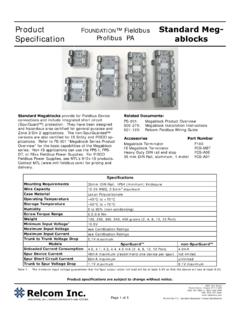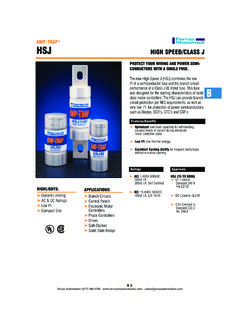Transcription of 501-123 Fieldbus Wiring Guide - Relcom Inc
1 Fieldbus Wiring Guide 4th Edition Relcom Inc. Doc. No.: 501 123 Rev.: i Fieldbus Wiring Guide The purpose of this Fieldbus Wiring Guide is to provide information about the Fieldbus infrastructure so that its Wiring system can be designed and installed for cost effective and reliable operation. There are many uses for Fieldbus and many ways it can be configured. It is not possible to give simple Wiring rules that cover all cases. For this reason, this Guide will first explain how Fieldbus works so that the Wiring system can be designed intelligently to achieve the best performance and most reliable operation with the lowest cost. Fieldbus is defined in IEC standard 61158 2. Detailed implementation requirements beyond the standard are available from the Fieldbus Foundation, an industry consortium that promotes Fieldbus technology. These more detailed specifications are needed so that devices made by different manufacturers are interoperable in a control system.
2 There is more to Fieldbus than the Wiring . For those wanting information about how Fieldbus works to control a process, refer to: Fieldbuses for Process Control; Jonas Burge, ISBN 1 55617 760 7 Foundation Fieldbus : A Pocket Guide ; Ian Verhappen and Augusto Pereira; ISBN 1 55617 775 5. Fieldbus Foundation 9005 Mountain Ridge Drive, Bowie Bldg, Suite 200 Austin, TX 78759 5316, USA Tel: 512 794 8890 Relcom Inc. 2221 Yew Street Forest Grove, OR 97116 USA Tel: 503 357 5607 800 382 3765 Fax: 503 357 0491 ii Doc. No.: 501 123 Rev.: Copyright and Intellectual Property Notices Relcom Inc. believes the information it furnishes to be accurate and reliable. However, the specification and information disclosed in this document are delivered AS IS . Relcom Inc. provides no warranties, whether expressed or implied, including warranties or condition for fitness for a particular purpose, merchantability, accuracy and non infringement.
3 Relcom Inc. assumes no responsibility for the use of this information nor for any infringement of patents or other rights of third parties which may result from its use. No license is granted by implication or otherwise under any patent, copyright, or other intellectual property right of Relcom Inc. except as specifically described herein. Relcom Inc. reserves the right to change specifications at any time without notice. Relcom Inc. has intellectual property rights ( Relcom Inc. IPR ) relating to implementations of the technology described in this publication ( the Technology ). In particular, and without limitation, Relcom Inc. IPR may include one or more patents or patent applications in the or other countries. Your limited right to use this publication does not grant you any right or license to Relcom Inc. IPR nor any right or license to implement the Technology. Relcom Inc. may, in its sole discretion, make available a limited license to Relcom Inc. IPR and/or to the Technology under a separate license agreement.
4 All rights reserved. No part of this manual may be reproduced, photocopied, stored on a retrieval system, or transmitted without the express prior consent of Relcom Inc. Copyright 2004 2011 Relcom Inc. Relcom Inc. and the Relcom Inc. logo are trademarks or registered trademarks of Relcom Inc. in the United States and other countries. All other trademarks and logos are the property of their respective owners. Doc. No.: 501 123 Rev.: iii Table of Contents Chapter 1: Fieldbus Network Concept .. 1 Chapter 2: Fieldbus Configuration .. 3 Chapter 3: 5 Chapter 4: Cable Selection, Installation, and Termination .. 6 Cable Selection .. 6 Cable Installation .. 7 Cable Termination .. 7 Chapter 5: Terminator .. 8 Chapter 6: Connecting Devices .. 9 Non Isolated Device Couplers .. 9 Isolated Device Couplers .. 11 Chapter 7: Fieldbus Power .. 12 Selecting a Fieldbus Power Supply.
5 13 Chapter 8: Fieldbus Segment Design .. 14 Power Distribution .. 14 14 Control System .. 14 Process Criticality .. 15 Area Classification .. 15 Chapter 9: Reliability Considerations .. 16 Segment Monitoring .. 19 Chapter 10: Hazardous Areas .. 20 Defining the Hazardous 20 Methods of Protection .. 21 Division 2 / Zone 2 .. 21 Division 1 / Zone 0,1 .. 23 Chapter 11: FISCO .. 25 Why choose FISCO? .. 26 Assembling FISCO segments .. 26 Other design considerations .. 27 Redundant FISCO power supplies .. 28 Chapter 12: Current Limiters .. 29 Chapter 13: Grounding/Earthing .. 30 Chapter 14: Preventing Fieldbus Physical Layer Problems .. 31 Common Physical Layer Problems .. 31 Causes of Physical Layer Problems .. 31 Preventing Physical Layer Problems .. 32 Training .. 32 Supervision .. 32 Monitoring .. 33 Tools .. 33 Examples .. 35 Preventing Physical Layer Problems .. 36 Table of Contents iv Doc.
6 No.: 501 123 Rev.: Glossary .. 37 References .. 39 Reference Documents .. 39 Certified Foundation Fieldbus Training Centers .. 40 Web sites .. 40 Appendix A: Signals .. 41 Appendix B: Availability Calculation .. 44 Appendix C: Fieldbus Segment Design Calculation .. 45 Doc. No.: 501 123 Rev.: 1 Chapter 1: Fieldbus Network Concept Summary: Fieldbus is a Local Area Network for process control that uses a single wire pair for powering multiple devices and carrying signals between those devices. Many different fieldbuses are currently available. This manual focuses on FoundationTM Fieldbus and Profibus PA, which will be referenced from here on as Fieldbus . Both of these networks share the same Wiring and powering scheme. They are significantly different in the communication protocol area, but that is outside the scope of this Guide . In a conventional 4 20mA Distributed Control System (DCS), two wires are used to connect to a device (normally using shielded twisted pair cable).
7 The devices may be instruments for input measurements such as temperature or pressure. Devices can also be outputs such as actuators and valves. The wires carry electrical power to a device. The device signals its measured value to the DCS s controller by varying the current it uses between 4 and 20 milliamps (mA). The controller gathers the data from a number of devices via the dedicated I/O cards, makes the necessary calculations, and sends commands by varying the current to the actuator or valve. For example, 4 mA may mean that the valve is totally closed and 20 mA may mean the valve is fully open. This is referred to as an analog system, because the data transmitted varies continuously between 4mA and 20mA. Figure : Conventional DCS (4 20mA or HART) Fieldbus also uses two wires to carry power to the devices, as can be seen in Figure For simplicity the cable shield is not shown although it is considered required for Fieldbus . A number of devices share the same Fieldbus wires.
8 Fieldbus devices vary the current on the two wires to send signals (See Chapter 3: Signals). The signal (data) is digital. This means that the values transmitted are discrete (not infinitely variable). This allows an error detection system to be employed to ensure that there are no errors induced by the transmission of data from the device. Because devices share the wires, the devices can send data to each other without a DCS controller (host). Fieldbus data transmissions have more information than just a single variable about temperature, pressure, or valve position. From the data shared between the devices, the devices can be configured to control the process. The host then only supervises the operation. This is called control in the field . Fieldbus Network Concept 2 Doc. No.: 501 123 Rev.: Fieldbus is a local area network (LAN) for process control.
9 Figure : Fieldbus (Foundation Fieldbus or Profibus PA) The two wires are a twisted pair similar to the usual 4 20 mA Wiring used for conventional devices. For more information, refer to Cable Selection, Installation, and Termination on page 6. For the sake of simplicity of Wiring diagrams, the wire pairs will be shown as a single line in the remainder of this document. Figure : Wiring Diagram Convention Doc. No.: 501 123 Rev.: 3 Chapter 2: Fieldbus Configuration Summary: A Fieldbus segment s Wiring carries power to devices and signals between devices. A DC power supply and a Fieldbus Power Supply are needed to provide power to the Fieldbus segment. Two Terminators are required at each end of the segment. Fieldbus is a process control local area network used for interconnecting sensors, actuators, and control devices. A common type of Fieldbus configuration is shown below. Figure : Common Fieldbus Segment Configuration A Trunk cable connects control room equipment with a number of devices in the field (for example, sensors such as temperature or pressure transducers and actuators such as valve positioners).
10 Multiple field devices can be connected with Spur cables to a Device Coupler (usually in a junction box). This is called a Chickenfoot, tree, or star topology. Devices can also be connected along the Trunk cable with a single drop Device Coupler. This is called a bus with spurs topology. Multiple topologies may be used in a single segment although the most common is a single Chickenfoot. A Terminator (T) is required at each end of the Fieldbus Trunk cable to avoid distorting signals and allow the twisted pair cable to carry digital signals. For convenience, Terminators are often included in Fieldbus Power Supplies and Device Couplers, eliminating the need for separate Terminators. Power to the devices is provided by a Fieldbus Power Supply. The Fieldbus Power Supply is needed to separate the bulk DC power supply from the Fieldbus Wiring so that the signals are not absorbed by the bulk DC power supply. The Fieldbus Power Supply is normally installed near the control room but could also be located in the field or in a marshalling panel.







